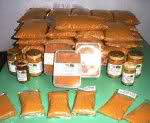Who would have guessed that something sweet would come out of normally intoxicating drink like “tuba”? Tuba, or coconut toddy, can be made into a healthy form of sugar, and is becoming a lucrative source of income for a lady farmer in Balingasag, Misamis Oriental.
 A local association in Balingasag, called Linabu Coconut Planters Association (LCPA) , to which Luisa Molo is a member, happens to have a three-year research project funded by the Asian Development Bank through the Coconut Genetic Network, implemented by the Philippine Coconut Authority.
A local association in Balingasag, called Linabu Coconut Planters Association (LCPA) , to which Luisa Molo is a member, happens to have a three-year research project funded by the Asian Development Bank through the Coconut Genetic Network, implemented by the Philippine Coconut Authority.
The linkage between the LCPA and these agencies enabled Molo to undergo skills training, which is a part of the project, and performed her own experiments which led to the perfection of the technology of extracting sugar from tuba.
Source of the alcoholic drink
Juice is extracted from the bud of the coconut’s inflorescence. The juice, most of the times is fermented, giving it the alcoholic kick that rural communities have grown to like. The fermented juice, called lambanog, is the common alcoholic drink in the coconut region. The fact that it is almost 98% proof means it got more kick than most alcoholic drinks served in finer circumstances.
But lambanog is not all that the coconut toddy is about: the sweet toddy extracted from the bud also contains essentially 12 to 18% sugar (sucrose).
From coco-sap to coco-sugar
Since the technology of turning coco sap to sugar has attracted private investors keen on marketing the resulting product abroad, the farmers in Molo’s locality were encouraged to extract toddy from their own coconut trees to satisfy rising demand.
The sap is boiled to get rid of its water component. This is usually done under moderate heat with constant stirring. Once the liquid thickens at 115 C, the thickened sap is removed from the heat under continuous stirring. The thick liquid will then finally break down into granular form, and there is your coconut sugar. It is important to air-dry the sugar before packing it for the market.
Healthy
Since the sugar is natural and organic, it is a healthy source of sweetening. Although it sells at about P100/kilo, it is bound to change, following law of supply and demand, that a large supply of coconut toddy would definitely help decrease the price.
A profitability analysis of the technology has been promising. Using enterprise budgeting, a farmer can earn almost P600,000 net income in a year using coconut sap from 100 coconut trees.
It was seen during the profitability analysis that even if the price of the sugar is decreased by 10 to 20%, the farmers would still earn a profit. Further reduction of prices will decrease their profit by certain percentage, though. But the analysis showed that if it is the coconut toddy supply that is reduced by 16%, the profit of the farmers will drop by 50%. If toddy supply further drops by 33%, the farmers will not have profit at all.
The profitability and sensitivity analysis of the coco-sugar enterprise showed both a promise and an opportunity. While a healthy sweetening can now be made available to sweettooths everywhere, the sensitivity of the economic viability of coco-sugar to market forces have opened opportunities for coconut farmers to increase their income by tapping their trees for that all-important toddy.
Source: Article by Maria Lizbeth Severa J. Baroña- bar.gov.ph
Do you like this Money Making Business and Ideas? content”> then please consider subscribing to our RSS feed. You can also subscribe by email and have new articles sent directly to your inbox. (Once you entered your e-mail address, you need to login to your e-mail account and click the link to confirm your subscription).
WHAT KIND OF COCONUT VARIETY DOES COCOS SUGAR REQUIRES?